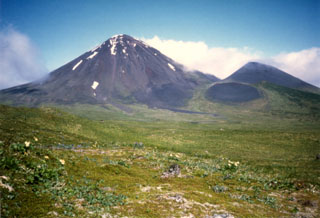Report on Semisopochnoi (United States) — 7 November-13 November 2018
Smithsonian Institution / US Geological Survey
Weekly Volcanic Activity Report, 7 November-13 November 2018
Managing Editor: Sally Sennert.
Please cite this report as:
Global Volcanism Program, 2018. Report on Semisopochnoi (United States) (Sennert, S, ed.). Weekly Volcanic Activity Report, 7 November-13 November 2018. Smithsonian Institution and US Geological Survey.
Semisopochnoi
United States
51.93°N, 179.58°E; summit elev. 1221 m
All times are local (unless otherwise noted)
AVO reported that three possible small explosions at Semisopochnoi were detected in infrasound data between 1951 and 2004 on 9 November. No associated ash clouds were observed in partly cloudy satellite images, and no other activity was noted during 7-11 November also in partly cloudy images. Images were cloudy during 12-13 November. The Aviation Color Code remained at Orange and Volcano Alert Level remained at Watch (both are the second highest levels on four-level scales).
Geological Summary. Semisopochnoi, the largest subaerial volcano of the western Aleutians, is 20 km wide at sea level and contains an 8-km-wide caldera. It formed as a result of collapse of a low-angle, dominantly basaltic volcano following the eruption of a large volume of dacitic pumice. The high point of the island is Anvil Peak, a double-peaked late-Pleistocene cone that forms much of the island's northern part. The three-peaked Mount Cerberus (renamed Mount Young in 2023) was constructed within the caldera during the Holocene. Each of the peaks contains a summit crater; lava flows on the N flank appear younger than those on the south side. Other post-caldera volcanoes include the symmetrical Sugarloaf Peak SSE of the caldera and Lakeshore Cone, a small cinder cone at the edge of Fenner Lake in the NE part of the caldera. Most documented eruptions have originated from Young, although Coats (1950) considered that both Sugarloaf and Lakeshore Cone could have been recently active.
Source: US Geological Survey Alaska Volcano Observatory (AVO)

